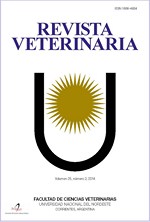Lactic acid microorganisms and yeasts as a supplement in fattening rations for cuyes (Cavia porcellus) Ayacucho, Peru
DOI:
https://doi.org/10.30972/vet.3326172Keywords:
Lactobacillus acidophilus, Lactobacillus casei, Yeast, Fattening, Cavia porcellusAbstract
Lactic acid microorganisms have a beneficial effect on the fattening of guinea pigs by improving the degradation of organic matter and preventing salmonellosis. The objective was to evaluate the lactic acid and yeast microorganisms as a supplement in the rations for the fattening of guinea pigs (Cavia porcellus) in Ayacucho. The bacteria were activated in lactose broth at 37°C for 48 hours in anaerobiosis, through consecutive dilutions, they were seeded on Rogosa sharpe agar and incubated at 37°C for 24 to 48 hours to count the number of live cells/ml. We used 20 weaned male kits with homogeneous size and weight. There were 5 treatments supplementing with lactic acid bacteria to the balanced food: T1 (Lactobacillus acidophilus), T2 (Lactobacillus casei), T3 (Lactobacillus acidophilus and Lactobacillus casei) and T5 (control) was provided at free discretion and alfalfa at 10% of their live weight plus water. It was proposed under the completely randomized design with 5 treatments, 2 repetitions and 2 guinea pigs as an experimental unit. The results shown for live weight and weight gain were not significant (p<0.05) and for feed consumption and feed conversion were significant and by the Tukey test it was found that the treatments with the combination T3 Lactobacillus acidophilus + Lactobacillus casei and T2 Lactobacillus casei were better, achieving commercial weight for the market in eight weeks of treatment, as well as better carcass yields, with this it can be intuited that microorganisms positively influence the development of guinea pigs.Downloads
References
Aguilar G, Bustamante J, Bazán B, Falcón N. 2011. Diagnóstico situacional de la crianza de cuyes en una zona de Cajamarca. Rev Inv Vet
Perú 22: 9-14.
Callañaupa P. 2001. Niveles de sustitución de alfalfa por concentrado comercial cogorno en la alimentación de cuyes machos mejorados de
recría. INIA-Canaán 2750 UNSCH, Ayacucho, Perú, 83.
Cano J. 2012. Efecto de la suplementación de probiótico líquido sobre los parámetros productivos en cuyes (Cavia porcellus) durante la fase de crecimiento y engorde. Tesis Tçit. Prof. Med. Vet., Lima 2012.
Cano J. 2016. Efecto de la suplementación con una mezcla probiótica sobre el comportamiento productivo de cuyes (Cavia porcellus) durante la
fase de crecimiento y acabado. Rev Investig Vet Perú 27: 1, 51-58.
Dani C, Biadaioli R, Bertini G, Martelli E, Rubaltelli FF. 2002. Probiotics feeding in prevention of urinary tract infection, bacterial sepsis and necrotizing entero colitis in preterm infants. Neonatology 82: 2, 103-108.
Guevara J, Carcelén F. 2014. Efecto de la suplementación de probióticos sobre los parámetros productivos de cuyes. Rev Peruana de Ing Quím 17: 2, 69-74.
Jara H. 2002. Engorde de cuyes mejorados, castrados y enteros con dos tipos de concentrado comercial y local en el Centro Experimental
Pampa del Arco (Tesis para optar tit. Ing. Agr. UNSCH), 120 pag. Ayacucho, Perú.
Molina M. 2008. Efecto probiótico de Lactobacillus acidophilus y Bacillus subtilis en cuyes (Cavia porcellus) de engorde lineal, Ecuador. Disponible en: http://repositorio.espe.edu.ec/bitstream/21000/2558/1/T-ESPEIASA%.2015.
Morales S, Mattos J, Call S. 2007. Efecto de la muña (Satureja parvifolia) en la dinámica de la infección por Salmonella entérica en cuyes. XXX Reunión de la Asociación Latinoamericana de Producción Animal, Cuzco, Perú.
Ortiz V. 2001. Engorde de cuyes mejorados hembras y machos alimentados con cebada y tarwi más suplemento mineral versus concentrado comercial en Pampa del Arco a 2750 msnm. Tesis
de Ing. Agrónomo, Ayacucho: UNSCH.
Preidis GA et al. 2011. Probiotics, enteric and diarrheal diseases, and global health. Gastroenterology 140: 1, 8. Andía, V.A. et al.: Engorde de cuyes.. Rev. Vet. 33: 2, 123-129, 2022 129
Quintana EE. 2009. Suplementación de dietas a base de alfalfa verde con harina de cebada más una mezcla mineral y su efecto sobre el rendimiento y eficiencia productiva en cuyes en crecimiento en el Valle del Mantaro. Disponible en: http://repositorio.espe.edu.ec/bitstream.
Sánchez SM et al. 2014. Efecto de la suplementación de ácidos orgánicos sobre parámetros productivos del cuy (Cavia porcellus). Rev Investig Vet Perú 25: 3, 381-389.
Zihler A, Chassard C, Lacroix C, Gagnon M. 2011. Protective effect of probiotics on Salmonella infectivity assessed with combined in vitro gut fermentation-cellular models. BMC Microbiology 11: 1, 264.
Downloads
Published
How to Cite
Issue
Section
License
Revista Veterinaria (Rev. Vet.) maintains a commitment to the policies of Open Access to scientific information, as it considers that both scientific publications as well as research investigations funded by public resources should circulate freely without restrictions. Revista Veterinaria (Rev. Vet.) ratifies the Open Access model in which scientific publications are made freely available at no cost online.











.jpg)
.jpg)



